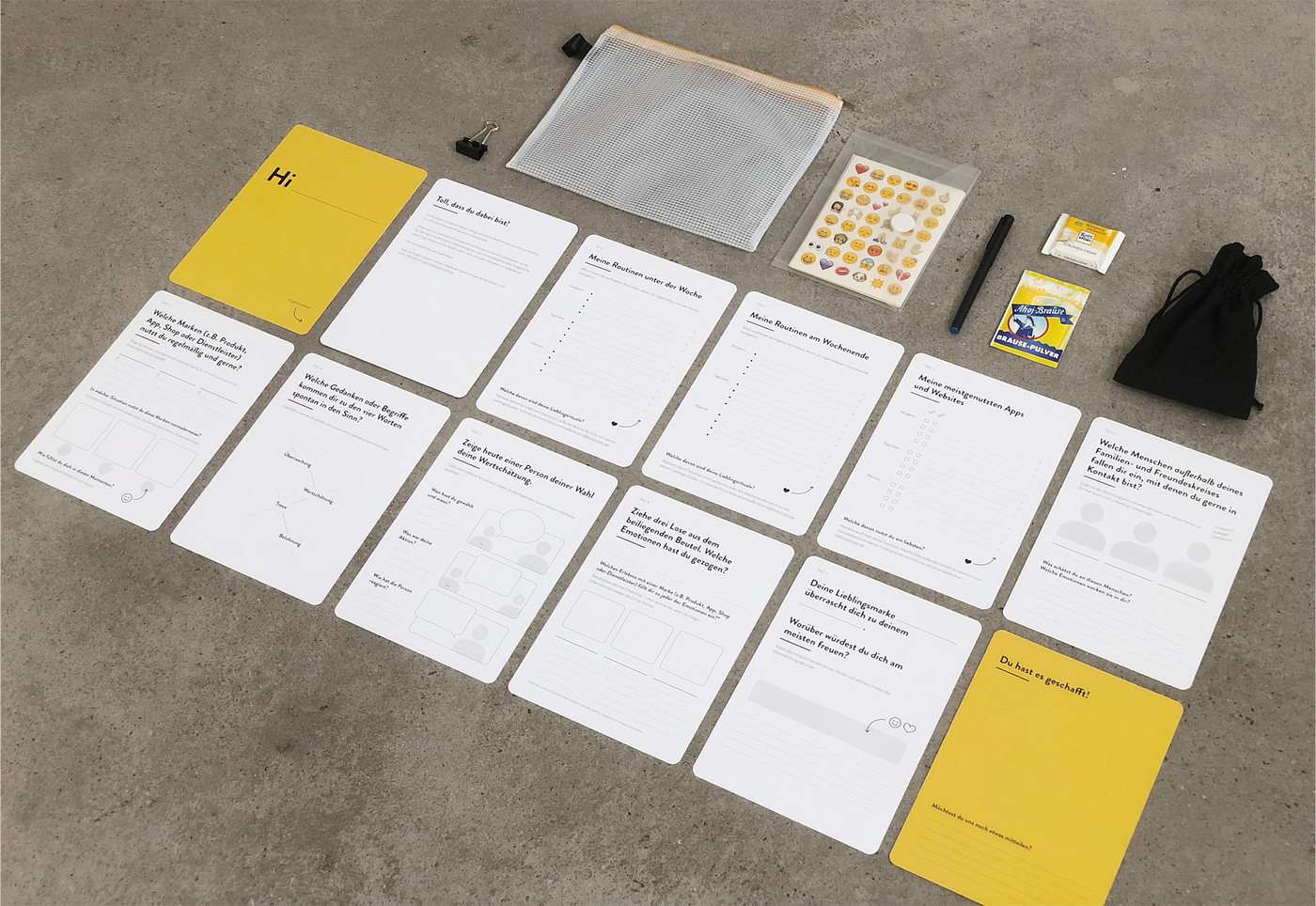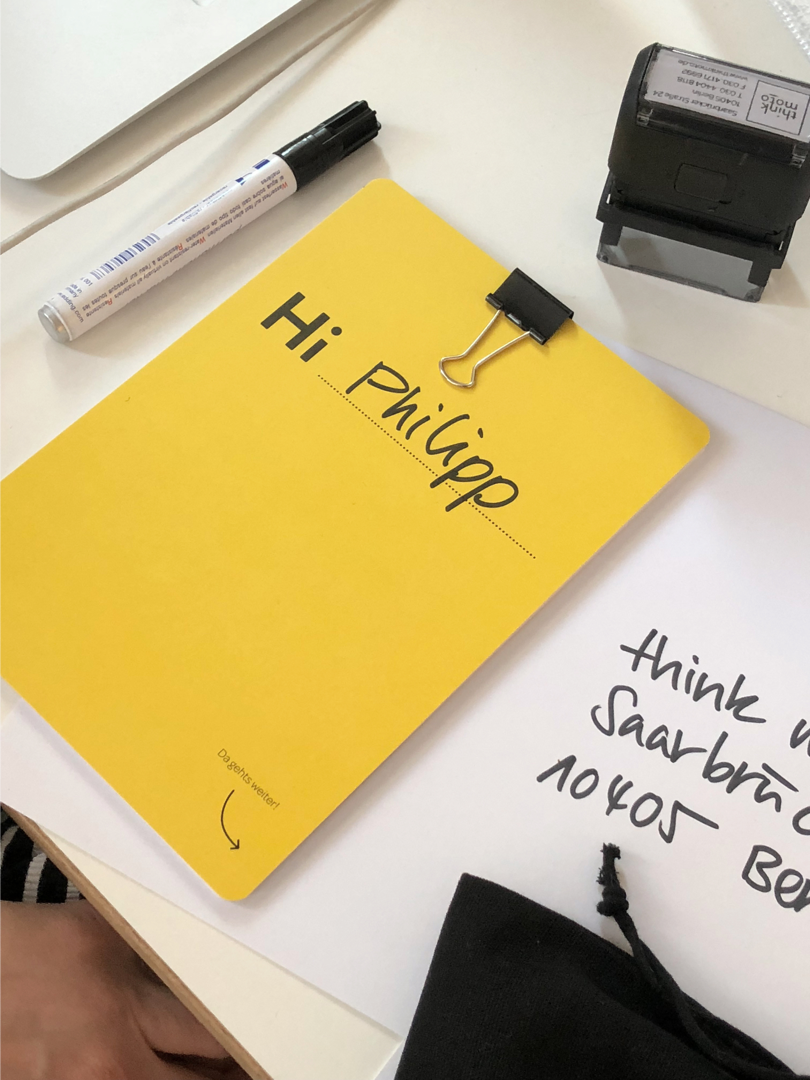How cultural probes make your user research even better
A deeper insight into users’ lives for a better understanding
When we developed ideas for future-oriented services for one of our clients last summer, an important part of the work began a few weeks earlier.
For a user-centric vision, we wanted to get an insight into the real world of our users, their behaviour, motivations and expectations, in order to develop a real understanding on an emotional level. For this reason, we decided to use cultural probes in combination with in-depth interviews as the research methods of our choice.
What are cultural probes?
Cultural probes — often also called diary study — are a research method that helps to understand the everyday challenges, goals and needs of users at the beginning of a design process. Participants document and reflect on certain aspects of their lives over a longer period of time. Since this method allows them to capture their real behavior themselves, you gain largely unbiased insights from their perspective, which makes cultural probes particularly valuable for an early inspiration phase.
How did we use cultural probes?
As already mentioned, our goal in using cultural probes was to get an insight into the lives of the participants and in particular into their relationships with brands and people. Based on our client’s key questions, we wanted to understand what drives people to regularly use certain brands and products and what creates an emotional relationship with them. In this context, we were not only interested in the brand context, but also in the relationship with their favourite neighbour or their bookseller of trust in order to be able to make analogies.
On this basis, we developed a set of activities for the twelve participants to work on for one week. The activities in our case did not relate to topics such as the documentation of public transport use or food purchases, which are often recorded by means of cultural probes. Instead, our interest was to sensitize the participants to their relationships, routines and expectations by asking more and more in-depth questions, so that they could increasingly immerse themselves in our field of interest over the course of the week. This meant that the activities were partly, but not always related to the day’s experiences.
In order to increase the fun factor and thus the motivation of the participants through variety, we added additional materials to the activity cards such as lottery tickets and emoji stickers, which were part of the individual tasks.

We deliberately designed the kit to be analogue rather than digital to ensure that the participants would really be able to concentrate on their tasks without being distracted or interrupted by digital notifications and the like.
This decision was rewarded by the participants, who were happy to take their pencils and paper for a change after a long working day at the computer, and who also noticed the loving design.
“The study inspired me to keep a diary again!”
About a week before the start of the study, we assigned the Swiss startup TestingTime to recruit the twelve participants. We carefully considered which criteria our participants should meet and tried to achieve a balance between factors such as age, place of residence and other living conditions. Within a few days, suitable participants appeared in TestingTime’s online lineup and we were able to contact them directly.
Before shipping, we test the kit in several rounds with colleagues and friends to ensure that the tasks are properly understood by all and bring the desired results. This gave us valuable hints, which we were able to implement before the start of the study, and also meant that the participants had no further questions after a short introduction and that we got back the activity cards filled out in line with our ideas at the end of the seven days.




The next step was to cluster the information, evaluate it and identify patterns in order to validate and deepen them in the subsequent interviews.
Especially in combination with the personal conversations, in which we talked more concretely about the product of our customer, the true value of this combination of methods became apparent — as you can read in the following.
How did the cultural probes help us in the end?
Cultural probes provide an insight into the participants’ world of life.
The cultural probes created an understanding of the behaviour and needs of the participants in their everyday lives. Through self-documentation, the insights were more personal and concrete than observations, more honest than interview responses, and documented a longer period of time.
Cultural probes put the participants in the right mood.
The cultural probes kit prompted the participants to deal with their behavior and needs for several days before the interview. In this way, they were mentally prepared for our conversation and the corresponding topics were more ‘present’.
Cultural probes create a personal atmosphere.
The cultural probes kit gave us the opportunity to introduce ourselves and involve the participants in our work. This promoted an open and trusting atmosphere during the interview and increased the motivation of the participants to contribute to a valuable result.
Cultural probes provide a starting point for conversations.
The results of the cultural probes were the basis for discussions again and again and helped us to quickly get to the relevant points in the interview. Specific statements could be better pinned down and validated against the background of the general needs and expectations of the participants.
Our conclusion
In our project, the combination of cultural probes and in-depth interviews has led to very good results and we plan to use them in the same or a similar way in the future.
It enabled a deeper relationship with the participants and created even better insights. It also allowed us to integrate the results optimally into our further work — the development of new services — as we now have the users with their environments and challenges much more present and lively in front of our eyes.
Want to learn more?
If you’d like to become an expert in UX Design, Design Thinking, UI Design, or another related design topic, then consider to take an online UX course from the Interaction Design Foundation. For example, Design Thinking, Become a UX Designer from Scratch, Conducting Usability Testing or User Research — Methods and Best Practices. Good luck on your learning journey!